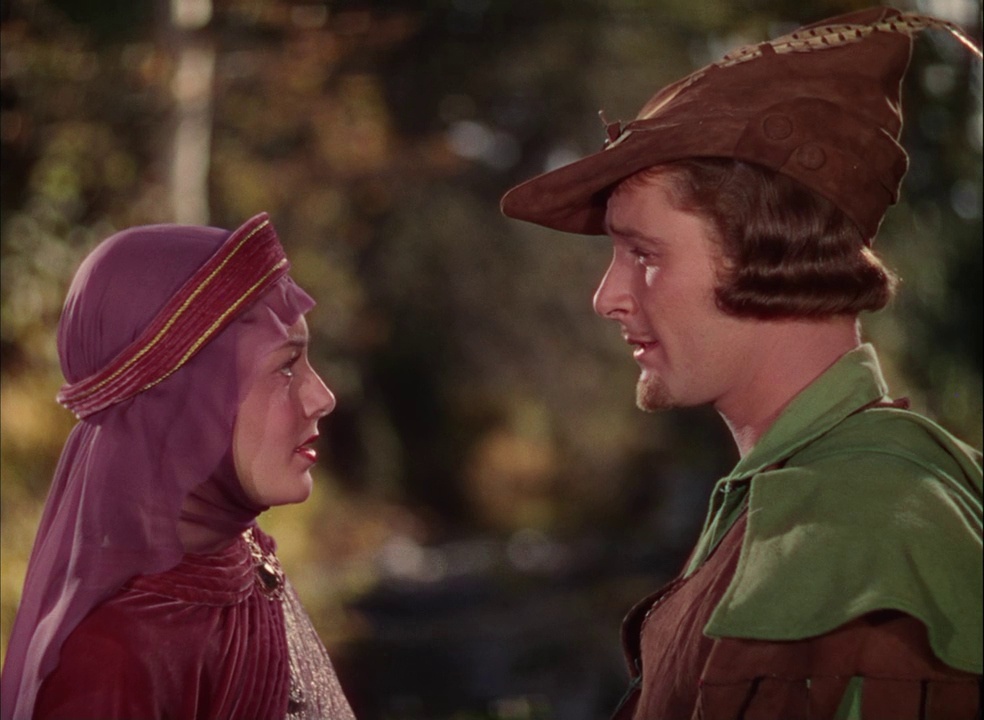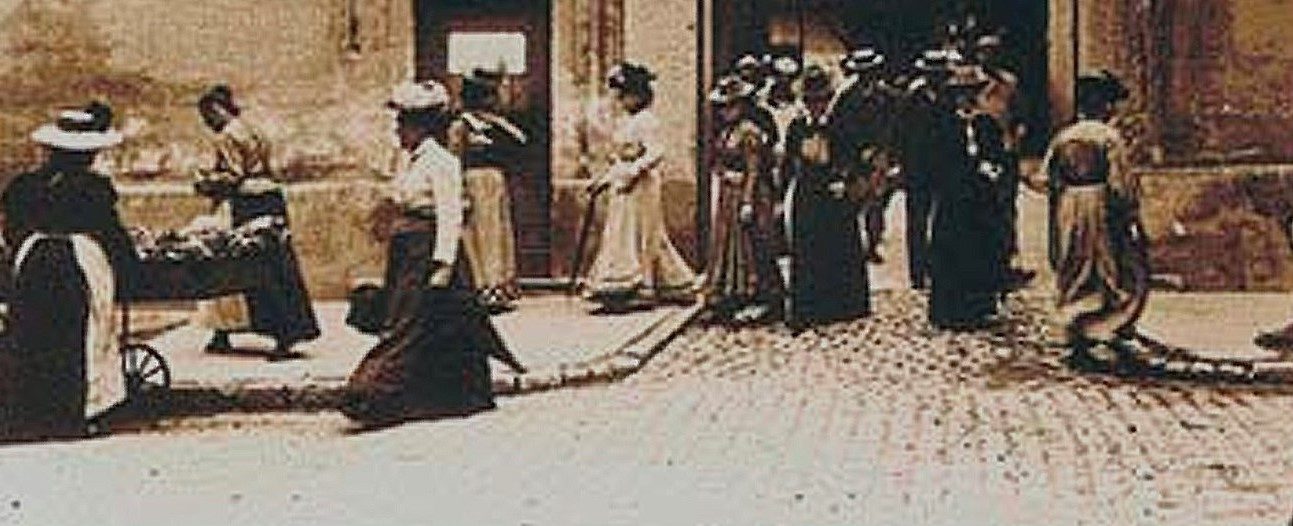United States, 1938
Directed by Michael Curtiz and William Keighley
With Errol Flynn (Robin Hood), Olivia de Havilland (Marion), Basil Rathbone (Guy of Gisbourne), Claude Rains (Prince John), Ian Hunter (King Richard the Lion-heart), Patric Knowles (Will Scarlett), Eugene Pallette (Friar Tuck), Alan Hale (Little John)
Actions do not only entertain but also enlighten the plot and its meaning, through repetitions, details, contrasts. In 1191 a banquet is held in the castle of Guy of Gisbourne, a noble allied to Prince John, who is jockeying for the top job in England after his brother and ruling king, Richard the Lion-heart, has been taken in hostage by the Emperor of the Holy Empire. The banquet gathers dignified and confident Norman noblemen around the prince and displays the Norman power, pomp and pride in a huge dining room inside the castle’s gray and fortified walls. As he barges into the place, Robin Hood, a noble who champions the rights of his fellow Saxons, cuts a lonely and defiant figure, and is mocked by Prince John as well as by Marion, a smart and charming ward of King Richard who could get married with Guy of Gisbourne.

A few sequences later, another banquet is held in the lair of Robin and his merry companions, inside the forest of Sherwood, after they have stolen the treasure Prince John has extorted from the poor. This is an open-air gathering where people guffaw and gulp down copious dishes to the dismay of the Normans they held prisoners, including Lady Marion. She tries again to explain to Robin Hood that he is erring on the wrong side. But his men make clear that the money they took would be used to pay a ransom to free the king, and their leader introduces her to the poorest of the people he tries to defend from Norman attacks and arrogance. That is enough to shatter her confidence. Earlier, she refused to eat; then in the heat of the general excitement she nibbled a morsel of meat; and at the end of the sequence she just gobbles the words of the dashing rebel.
The sets and incidents of each banquet and the sheer contrast between them speak volumes about the social and political troubles of the time and squarely show who is right and who is wrong, the line being drawn by the relations one can or cannot have with the people. The story deals with clear moral choices and the narration describes candidly and effectively the terms of the alternative and the attitudes of the characters as they stick to their principles, or indeed change their mind (and in the second banquet change brings about the charming subplot of the romantic affairs of Marion).
After the first banquet there is a dramatic melee as guards try to catch Robin Hood who scrapes an exit with gusto but only just. At the end of the film, inside the same dull walls, another fight erupts but this time defeat is certain for the dishonest Normans, as the camera deftly shows that they are how outnumbered, in particular because King Richard has managed to come back and has rallied to Robin Hood’s party. The contrast points to the amazing luck of the rebellious Saxon nobleman, who has succeeded to build a large following ready to fight; this is one of the main strands of the narrative and it is usually narrated by vignettes telling how Robin Hood meets some of his main companions, like Little John and Friar Tuck, and creates a community.
Anyway, isn’t their victory inevitable? The Saxons loyal to the noble turncoat are many and easily blend into the landscape and the population; the camera mischievously captures how they become part of the forest with a few branches, ready to trap the Norman troops, or mingle and toil away with the city’s inhabitants, waiting for the best moment to free their leader. Confronted with numerous fighters spread out in the wild the cruel Norman commanders seem lonely, and they are actually shot standing away from other characters (in particular their Saxon victims) against a dull background as an arrow flies and kills them.
The jovial episodes featuring Robin Hood with his merry companions usually occur in the bright light of the sun and in the verdant landscape of England, and stand in stark contrast with the intimate conversations in the castle where a darkly dressed Prince John and his sidekicks plot against the rebels and justice. The symbolism of the mise en scène is once again obvious (character color coding feels like an injunction all along) but the film thrives on this emphasis on the need to fight about fairness, a fight that would always strike a chord. In a nation which was still reeling from the Great Depression and watching the world descending into chaos, the topic was certainly relevant.
The film is not only about carefully composed scenes and savvy montage; it offers thrills at a fast-paced rhythm and in a way the narrative is a series of dramatic, cliff-hanging and riveting climatic actions, from the fight following the first banquet to the last, following this time the failed coronation of Prince John, and including the ingenious theft of Prince John’s treasure and an attempt to hang Robin Hood after he was trapped. The film is unabashedly a swashbuckling entertainment that highlights the ups and downs of a necessary fight and enjoys capturing tensions and body blows in a clever and flamboyant manner.
“The Adventures of Robin Hood” is shot in Technicolor. This complicated film color technique has so far been used for musicals, not for other projects. The Warner Bros. made the radical choice to use the Technicolor technique for this swashbuckling period piece so as to broaden the studio’s appeal and ambition, and put a lot of money in the production, which ended up probably as the most costly film it ever made at this point of its history. The directorial job was given to William Keighley but the dailies the studio executives watched failed to please them and they hired Michael Curtiz to bring more zest to the project. He did. The end result is a remarkably brilliant and fluid movie and Curtiz fully conveys the meaning of the tale through an intelligent and elegant use of the camerawork, sets and props and a faultless sense of rhythm and contrasts. The actors are well cast and well directed, starting with Errol Flynn whose allure and fitness make him an unforgettable 1938 Robin Hood (a role that another seducing and athletic gentleman of Hollywood played with the same zest and skills, namely Douglas Fairbanks, in the “Robin Hood” directed in 1922 by Allan Dwan).

